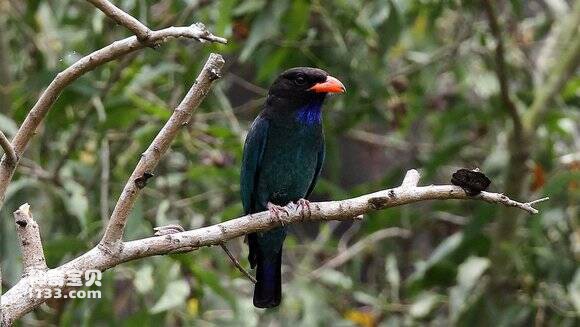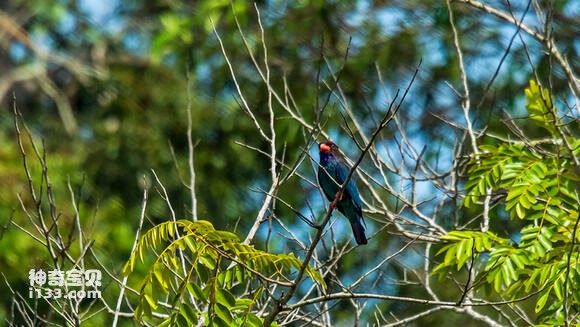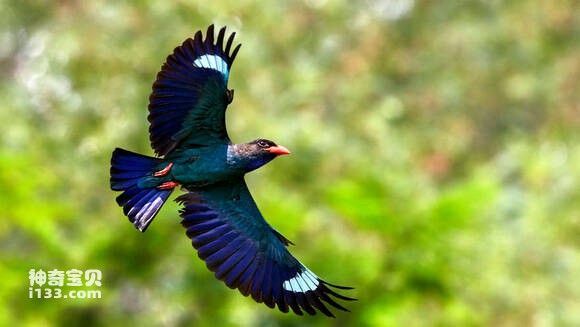Eurystomus orientalis Linnaeus
IUCN
LCBasic Information
Scientific classification
- name:Eurystomus orientalis Linnaeus
- Scientific Name:Eurystomus orientalis Linnaeus,Broad-billed Roller,Oriental Dollarbird
- Outline:Climbing birds
- Family:
Vital signs
- length:24.1-29cm
- Weight:107-194g
- lifetime:No textual research information is available
Feature
The name is translated from Japanese
Distribution and Habitat
It is found in Australia, Bangladesh, Bhutan, Cambodia, Brunei, India, Indonesia, Japan, Korea, South Korea, Laos, Malaysia, Micronesia, Myanmar, Nepal, Palau, Papua New Guinea, Philippines, Russia, Singapore, Solomon Islands, Sri Lanka, Thailand, Vietnam and Timor-Leste.
It was found on Christmas Island in New Zealand.
China is distributed in the Lesser Khingan Mountains of Heilongjiang Province, Changbai Mountains of Jilin Province, Liaoning, Hebei, Ningxia, and south to Sichuan, Guizhou, Yunnan, Guangxi, Guangdong, Hong Kong, Macao, Hainan Island, Fujian and Taiwan.
The Tri-treasure bird mainly inhabits tall trees along roadsides and river valleys in coniferous and broad-leaved forests. [4] Often live alone or in pairs in mountain or plain forests, but also like to open forest edges or reclaimed forest activities, early and late frequent activities. When the weather is hot, it often roosts in trees in dense forests, or on large treetops in more open areas.
Appearance
The three-treasure bird has a large, broad head and a flat top. Dark brown from head to neck, dark coppery green covering nape, upper back, shoulders, lower back, waist and tail. The two wings are similar to the back, but brighter and bluer than the back. Primary feathers dark brown, base with a broad sky blue stripes; Secondary feathers dark brown, with dark blue luster; Tertiary feather base blue-green. Tail is black, tinged with blue, base is the same as back, sometimes tinged with bluish-purple. Chin black, throat and thorax black stained blue, with cobalt blue plume, the rest of the lower body blue-green. Axillary and underwing coverts pale blue-green. [1]
The plumage of the female bird is darker than that of the male bird, which is not as bright as the male bird.
Young birds resemble adults, but the plumage is darker, the underside is nearly greenish-brown, and the throat is not blue.
Dark brown iris, vermilion mouth, black upper mouth tip, vermilion feet, toes, black cl
Details
Eurystomus orientalis Linnaeus, Broad-billed Roller, Oriental Dollarbird, specific habits are unknown.
Sanbao birds like to eat green scarab beetles and other beetles, but also eat locusts, longans, golden flower insects, pear tigers, lifting tail insects, stone silkworm, kowtowing insects and so on. Foraging often rotates back and forth in the air, hunting by non-stop flying, faster, after capturing insects and returning to the original branches. Tri-treasure birds rarely forage on the ground. Make a gruff "kreck..." when flying or resting on branches. "kreck."
The three-treasure bird usually lives on the dead trees in the open areas near the forest, and flies away immediately when approached, occasionally taking off to chase insects passing by, or diving down to catch insects on the ground. Flying posture like a nighthawk, strange, heavy, sometimes slow flight, long wings evenly and rhythmically swing up and down, and sometimes rush straight up, or turn straight down, circling or flapping at random, and constantly issuing a monotonous and coarse "rattle" sound. Three or two birds sometimes fly or dive together at dusk, especially during courtship. It is sometimes besieged by flocks of small birds, whose head and beak make it look like a bird of prey.

Sanbao birds like to eat green scarab beetles and other beetles, but also eat locusts, longans, golden flower insects, pear tigers, lifting tail insects, stone silkworm, kowtowing insects and so on. Foraging often rotates back and forth in the air, hunting by non-stop flying, faster, after capturing insects and returning to the original branches. Tri-treasure birds rarely forage on the ground. Make a gruff "kreck..." when flying or resting on branches. "kreck."
The three-treasure bird usually lives on the dead trees in the open areas near the forest, and flies away immediately when approached, occasionally taking off to chase insects passing by, or diving down to catch insects on the ground. Flying posture like a nighthawk, strange, heavy, sometimes slow flight, long wings evenly and rhythmically swing up and down, and sometimes rush straight up, or turn straight down, circling or flapping at random, and constantly issuing a monotonous and coarse "rattle" sound. Three or two birds sometimes fly or dive together at dusk, especially during courtship. It is sometimes besieged by flocks of small birds, whose head and beak make it look like a bird of prey.

The global population size of Sanbao has not been quantified, but the species is reported to occur frequently in its range, with population estimates by country and region as follows: 100-10,000 pairs of adult birds and 50-1000 travellers in China, with less than 1000 travellers in Taiwan; There are 100-10,000 pairs of adult birds and 50-10,000 travellers in Korea; Less than 100,000 pairs of adult birds and less than 1,000 travellers in Japan; There are 100-10,000 pairs of adult birds and 50-1000 travellers in Russia.
In 806 AD (Yuan and the first year of the Tang Dynasty), the Japanese monk Master of Buddhism, the title of Konghai, returned to Japan from China, in Koye Mountain's Kumgang Feng Temple, wrote down the three treasure birds "idle forest" seven unique, for the famous poem about the Buddhist monk's three treasure birds, poetry cloud: "Idle forest sitting alone in the grass hall, the sound of the three treasure a bird. When a bird speaks, a person has a heart, and the sound of the heart is gone."
The ancient Japanese book "Nature Spirit collection to fill the Que banknote" also sees a poem: "Solitary moon Cen Chang corridor Lin Xiao, three treasure wind micro a spirit bird." Call out the normal reality, ten realms of sound together."
In modern Japan, the Meiji restoration of Takamatsu Han Confucian constant Fujisawa sang: "The lack of moon broken clouds, the sky is ready to dawn, the Zen hall songs to listen to birds." The dream of human gain and loss is weeded, and the sound of three treasures is muddy."
Included in the State Forestry Administration issued on August 1, 2000, "State protection of beneficial or important economic and scientific research value of land wildlife List" (No. 277).
Listed in the "China Red List of Species", assessment grade - non-threatened species (LC).
It is not listed in the Washington Convention on International Trade in Endangered Species of Wild Fauna and Flora (CITES).
Listed in the International Union for Conservation of Nature Red List of Threatened Species (IUCN) 2016 ver 3.1 - Species not at Risk (LC).
Protect wild animals and eliminate wild meat.
Maintaining ecological balance is everyone's responsibility!








